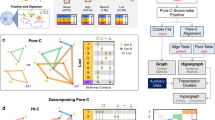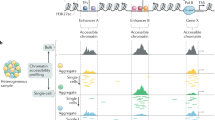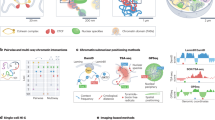Abstract
The genome of an organism is a dynamic physical entity, comprising genomic DNA bound to many different proteins and organized into chromosomes. A thorough characterization of the physical genome is relevant to our understanding of processes such as the regulation of gene expression, DNA replication and repair, recombination, chromosome segregation, epigenetic inheritance and genomic instability. Methods based on microarrays are beginning to provide a detailed picture of this physical genome, and they complement the genome-wide studies of mRNA expression profiling that have previously been so successful.
This is a preview of subscription content, access via your institution
Access options
Subscribe to this journal
Receive 12 print issues and online access
$209.00 per year
only $17.42 per issue
Buy this article
- Purchase on Springer Link
- Instant access to full article PDF
Prices may be subject to local taxes which are calculated during checkout

Bob Crimi

Bob Crimi

Bob Crimi
Similar content being viewed by others
References
Reid, J.L., Iyer, V.R., Brown, P.O. & Struhl, K. Coordinate regulation of yeast ribosomal protein genes is associated with targeted recruitment of Esa1 histone acetylase. Mol. Cell 6, 1297–1307 (2000).
Iyer, V.R. et al. Genomic binding sites of the yeast cell-cycle transcription factors SBF and MBF. Nature 409, 533–538 (2001).
Ren, B. et al. Genome-wide location and function of DNA binding proteins. Science 290, 2306–2309 (2000).
Simon, I. et al. Serial regulation of transcriptional regulators in the yeast cell cycle. Cell 106, 697–708 (2001).
Lieb, J.D., Liu, X., Botstein, D. & Brown, P.O. Promoter-specific binding of Rap1 revealed by genome-wide maps of protein–DNA association. Nature Genet. 28, 327–334 (2001).
Wyrick, J.J. et al. Genome-wide distribution of ORC and MCM proteins in S. cerevisiae: high-resolution mapping of replication origins. Science 294, 2357–2360 (2001).
Kurdistani, S.K., Robyr, D., Tavazoie, S. & Grunstein, M. Genome-wide binding map of the histone deacetylase Rpd3 in yeast. Nature Genet. 31, 248–254 (2002).
Robyr, D. et al. Microarray deacetylation maps determine genome-wide functions for yeast histone deacetylases. Cell 109, 437–446 (2002).
Damelin, M. et al. The genome-wide localization of Rsc9, a component of the RSC chromatin-remodeling complex, changes in response to stress. Mol. Cell 9, 563–573 (2002).
Ng, H.H., Robert, F., Young, R.A. & Struhl, K. Genome-wide location and regulated recruitment of the RSC nucleosome-remodeling complex. Genes Dev. 16, 806–819 (2002).
Spellman, P.T. et al. Comprehensive identification of cell cycle-regulated genes of the yeast Saccharomyces cerevisiae by microarray hybridization. Mol. Biol. Cell 9, 3273–3297 (1998).
Zhang, Y. & Reinberg, D. Transcription regulation by histone methylation: interplay between different covalent modifications of the core histone tails. Genes Dev. 15, 2343–2360 (2001).
Sun, Z.W. & Allis, C.D. Ubiquitination of histone H2B regulates H3 methylation and gene silencing in yeast. Nature 418, 104–108 (2002).
van Steensel, B., Delrow, J. & Henikoff, S. Chromatin profiling using targeted DNA adenine methyltransferase. Nature Genet. 27, 304–308 (2001).
Meselson, M. & Stahl, F. The replication of DNA in Escherichia coli. Proc. Natl Acad. Sci. USA 44, 671–682 (1958).
Raghuraman, M.K. et al. Replication dynamics of the yeast genome. Science 294, 115–121 (2001).
Khodursky, A.B. et al. Analysis of topoisomerase function in bacterial replication fork movement: use of DNA microarrays. Proc. Natl Acad. Sci. USA 97, 9419–9424 (2000).
Gerton, J.L. et al. Inaugural article: global mapping of meiotic recombination hotspots and coldspots in the yeast Saccharomyces cerevisiae. Proc. Natl Acad. Sci. USA 97, 11383–11390 (2000).
Ng, H.H. & Bird, A. DNA methylation and chromatin modification. Curr. Opin. Genet. Dev. 9, 158–163 (1999).
Jones, P.A. & Laird, P.W. Cancer epigenetics comes of age. Nature Genet. 21, 163–167 (1999).
Jackson-Grusby, L. et al. Loss of genomic methylation causes p53-dependent apoptosis and epigenetic deregulation. Nature Genet. 27, 31–39 (2001).
Karpf, A.R. et al. Inhibition of DNA methyltransferase stimulates the expression of signal transducer and activator of transcription 1, 2, and 3 genes in colon tumor cells. Proc. Natl Acad. Sci. USA 96, 14007–14012 (1999).
Liang, G., Gonzales, F.A., Jones, P.A., Orntoft, T.F. & Thykjaer, T. Analysis of gene induction in human fibroblasts and bladder cancer cells exposed to the methylation inhibitor 5-aza-2′-deoxycytidine. Cancer Res. 62, 961–966 (2002).
Suzuki, H. et al. A genomic screen for genes upregulated by demethylation and histone deacetylase inhibition in human colorectal cancer. Nature Genet. 31, 141–149 (2002).
Huang, T.H., Perry, M.R. & Laux, D.E. Methylation profiling of CpG islands in human breast cancer cells. Hum. Mol. Genet. 8, 459–470 (1999).
Tompa, R. et al. Genome-wide profiling of DNA methylation reveals transposon targets of CHROMOMETHYLASE3. Curr. Biol. 12, 65–68 (2002).
Yan, P.S. et al. Dissecting complex epigenetic alterations in breast cancer using CpG island microarrays. Cancer Res. 61, 8375–8380 (2001).
Yan, P.S. et al. CpG island arrays: an application toward deciphering epigenetic signatures of breast cancer. Clin. Cancer Res. 6, 1432–1438 (2000).
Wei, S.H. et al. Methylation microarray analysis of late-stage ovarian carcinomas distinguishes progression-free survival in patients and identifies candidate epigenetic markers. Clin. Cancer Res. 8, 2246–2252 (2002).
Shi, H. et al. Expressed CpG island sequence tag microarray for dual screening of DNA hypermethylation and gene silencing in cancer cells. Cancer Res. 62, 3214–3220 (2002).
Gitan, R.S., Shi, H., Chen, C.M., Yan, P.S. & Huang, T.H. Methylation-specific oligonucleotide microarray: a new potential for high-throughput methylation analysis. Genome Res. 12, 158–164 (2002).
Adorjan, P. et al. Tumour class prediction and discovery by microarray-based DNA methylation analysis. Nucleic Acids Res. 30, e21 (2002).
Kallioniemi, A. et al. Comparative genomic hybridization for molecular cytogenetic analysis of solid tumors. Science 258, 818–821 (1992).
Solinas-Toldo, S. et al. Matrix-based comparative genomic hybridization: biochips to screen for genomic imbalances. Genes Chromosom. Cancer 20, 399–407 (1997).
Pinkel, D. et al. High resolution analysis of DNA copy number variation using comparative genomic hybridization to microarrays. Nature Genet. 20, 207–211 (1998).
Pollack, J.R. et al. Genome-wide analysis of DNA copy-number changes using cDNA microarrays. Nature Genet. 23, 41–46 (1999).
Snijders, A.M. et al. Assembly of microarrays for genome-wide measurement of DNA copy number. Nature Genet. 29, 263–264 (2001).
Cai, W.W. et al. Genome-wide detection of chromosomal imbalances in tumors using BAC microarrays. Nature Biotechnol. 20, 393–396 (2002).
Hodgson, G. et al. Genome scanning with array CGH delineates regional alterations in mouse islet carcinomas. Nature Genet. 29, 459–464 (2001).
Massion, P.P. et al. Genomic copy number analysis of non-small cell lung cancer using array comparative genomic hybridization: implications of the phosphatidylinositol 3-kinase pathway. Cancer Res. 62, 3636–3640 (2002).
Heiskanen, M.A. et al. Detection of gene amplification by genomic hybridization to cDNA microarrays. Cancer Res. 60, 799–802 (2000).
Geschwind, D.H. et al. Klinefelter's syndrome as a model of anomalous cerebral laterality: testing gene dosage in the X chromosome pseudoautosomal region using a DNA microarray. Dev. Genet. 23, 215–229 (1998).
Lucito, R. et al. Detecting gene copy number fluctuations in tumor cells by microarray analysis of genomic representations. Genome Res. 10, 1726–1736 (2000).
Kato-Maeda, M. et al. Comparing genomes within the species Mycobacterium tuberculosis. Genome Res. 11, 547–554 (2001).
Steinmetz, L.M. et al. Dissecting the architecture of a quantitative trait locus in yeast. Nature 416, 326–330 (2002).
Lindblad-Toh, K. et al. Loss-of-heterozygosity analysis of small-cell lung carcinomas using single-nucleotide polymorphism arrays. Nature Biotechnol. 18, 1001–1005 (2000).
Mei, R. et al. Genome-wide detection of allelic imbalance using human SNPs and high-density DNA arrays. Genome Res. 10, 1126–1137 (2000).
Schubert, E.L. et al. Single nucleotide polymorphism array analysis of flow-sorted epithelial cells from frozen versus fixed tissues for whole genome analysis of allelic loss in breast cancer. Am. J. Pathol. 160, 73–79 (2002).
Dean, F.B. et al. Comprehensive human genome amplification using multiple displacement amplification. Proc. Natl Acad. Sci. USA 99, 5261–5266 (2002).
Wilhelm, M. et al. Array-based comparative genomic hybridization for the differential diagnosis of renal cell cancer. Cancer Res. 62, 957–960 (2002).
Fritz, B. et al. Microarray-based copy number and expression profiling in dedifferentiated and pleomorphic liposarcoma. Cancer Res. 62, 2993–2998 (2002).
Takeo, S. et al. Examination of oncogene amplification by genomic DNA microarray in hepatocellular carcinomas: comparison with comparative genomic hybridization analysis. Cancer. Genet. Cytogenet. 130, 127–132 (2001).
Hui, A.B., Lo, K.W., Yin, X.L., Poon, W.S. & Ng, H.K. Detection of multiple gene amplifications in glioblastoma multiforme using array-based comparative genomic hybridization. Lab. Invest. 81, 717–723 (2001).
Hui, A.B., Lo, K.W., Teo, P.M., To, K.F. & Huang, D.P. Genome wide detection of oncogene amplifications in nasopharyngeal carcinoma by array based comparative genomic hybridization. Int. J. Oncol. 20, 467–473 (2002).
Zhao, J. et al. Combined comparative genomic hybridization and genomic microarray for detection of gene amplifications in pulmonary artery intimal sarcomas and adrenocortical tumors. Genes Chromosom. Cancer 34, 48–57 (2002).
Kauraniemi, P., Barlund, M., Monni, O. & Kallioniemi, A. New amplified and highly expressed genes discovered in the ERBB2 amplicon in breast cancer by cDNA microarrays. Cancer Res. 61, 8235–8240 (2001).
Clark, J. et al. Identification of amplified and expressed genes in breast cancer by comparative hybridization onto microarrays of randomly selected cDNA clones. Genes Chromosom. Cancer 34, 104–114 (2002).
Pollack, J.R. et al. Microarray analysis reveals a major direct role of DNA copy number alteration in the transcriptional program of human breast tumors. Proc. Natl Acad. Sci. USA 99, 12963–12968 (2002).
Varis, A. et al. Targets of gene amplification and overexpression at 17q in gastric cancer. Cancer Res. 62, 2625–2629 (2002).
Bruder, C.E. et al. High resolution deletion analysis of constitutional DNA from neurofibromatosis type 2 (NF2) patients using microarray-CGH. Hum. Mol. Genet. 10, 271–282 (2001).
Veltman, J.A. et al. High-throughput analysis of subtelomeric chromosome rearrangements by use of array-based comparative genomic hybridization. Am. J. Hum. Genet. 70, 1269–1276 (2002).
Lin, J.Y. et al. Physical mapping of genes in somatic cell radiation hybrids by comparative genomic hybridization to cDNA microarrays. Genome Biol. 3, research0026.1–research0026.7 (2002).
Behr, M.A. et al. Comparative genomics of BCG vaccines by whole-genome DNA microarray. Science 284, 1520–1523 (1999).
Weinmann, A.S., Yan, P.S., Oberley, M.J., Huang, T.H. & Farnham, P.J. Isolating human transcription factor targets by coupling chromatin immunoprecipitation and CpG island microarray analysis. Genes Dev. 16, 235–244 (2002).
Ren, B. et al. E2F integrates cell cycle progression with DNA repair, replication, and G2/M checkpoints. Genes Dev. 16, 245–256 (2002).
Berman, B.P. et al. Exploiting transcription factor binding site clustering to identify cis-regulatory modules involved in pattern formation in the Drosophila genome. Proc. Natl Acad. Sci. USA 99, 757–762 (2002).
Markstein, M., Markstein, P., Markstein, V. & Levine, M.S. Genome-wide analysis of clustered dorsal binding sites identifies putative target genes in the Drosophila embryo. Proc. Natl Acad. Sci. USA 99, 763–768 (2002).
Levy, S., Hannenhalli, S. & Workman, C. Enrichment of regulatory signals in conserved non-coding genomic sequence. Bioinformatics 17, 871–877 (2001).
Author information
Authors and Affiliations
Ethics declarations
Competing interests
The authors declare no competing financial interests.
Rights and permissions
About this article
Cite this article
Pollack, J., Iyer, V. Characterizing the physical genome. Nat Genet 32 (Suppl 4), 515–521 (2002). https://doi.org/10.1038/ng1035
Issue Date:
DOI: https://doi.org/10.1038/ng1035



